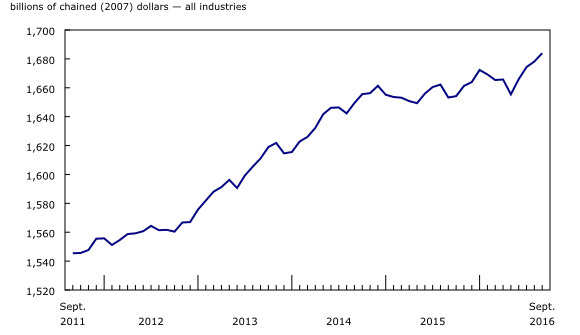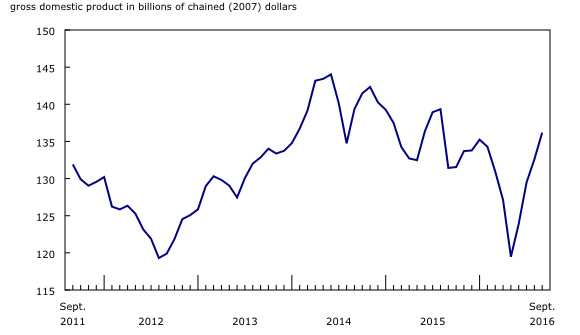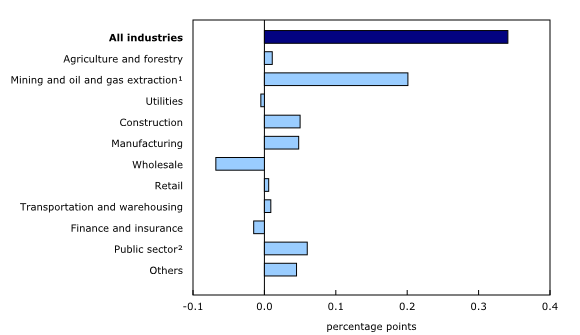Gross domestic product by industry, September 2016
Archived Content
Information identified as archived is provided for reference, research or recordkeeping purposes. It is not subject to the Government of Canada Web Standards and has not been altered or updated since it was archived. Please "contact us" to request a format other than those available.
Released: 2016-11-30
September 2016
0.3% 
(monthly change)
Real gross domestic product rose for the fourth consecutive month in September, growing 0.3%. Higher output in the mining, quarrying, and oil and gas extraction sector was the major contributor to the increase.
Goods-producing industries grew by 1.1% as all sectors increased, led by mining, quarrying and oil and gas extraction.
Service-producing industries edged up 0.1%. Most sectors advanced, led by gains in the public sector (education, health and public administration combined), real estate and rental and leasing, and professional services. These increases were mostly offset by declines in wholesale trade, information and cultural industries and finance and insurance services.
Mining, quarrying and oil and gas extraction continues to grow
The output of the mining, quarrying and oil and gas extraction sector was up 2.7% in September. After declining in the first half of 2016, the output of this sector has grown every month since June, reversing the earlier declines.
Oil and gas extraction (+3.8%) rose for a fourth consecutive month in September after declining from February to May. Both conventional oil and gas (+1.7%) and non-conventional oil extraction (+6.5%) increased in September.
Support activities for mining and oil and gas extraction grew by 5.0% as rigging and drilling services increased.
Mining excluding the oil and gas extraction subsector fell 2.0%. After recording a strong August, non-metallic mineral mining declined 3.9% in September as a result of a decrease in potash mining due to lower exports. Coal mining and metal ore mining also posted lower output.
Construction increases
Construction increased 0.7% in September following four consecutive monthly declines. Residential construction was the major contributor to the increase, rising 1.7%. Non-residential and repair construction also rose, while engineering construction edged down.
Real estate and rental and leasing rose 0.2% in September. Real estate agents and brokers were up 0.3% as continued declines in the Lower Mainland of British Columbia were more than offset by continued gains in the Greater Toronto Area.
Manufacturing output rises
Manufacturing output rose 0.5% in September. Both durable and non-durable manufacturing contributed to the growth.
Durable manufacturing was up 0.8%, led by increases in machinery (+4.7%) and fabricated metal products (+3.0%) manufacturing. Transportation equipment output declined 1.5% as the output of motor vehicle manufacturing, motor vehicle body and parts, aerospace and other transportation equipment fell. Primary metal manufacturing also declined.
Non-durable manufacturing edged up 0.1%. Increases in food and paper manufacturing were mainly offset by declines in chemical and petroleum and coal products.
The public sector increases
The public sector (education, health and public administration combined) increased 0.3% in September as all three subsectors rose. Educational services rose by 0.4% in September, while heath care and social assistance increased 0.3%. Public administration was up 0.2%.
Wholesale trade declines and retail trade rises
Wholesale trade had the largest negative impact on real gross domestic product in September, down 1.3%. Machinery, equipment and supplies, miscellaneous wholesaling (such as agricultural supplies and recyclable materials) and food, beverage and tobacco registered the largest declines.
Retail trade edged up 0.1% in September, led by motor vehicle and parts dealers and general merchandise stores. The most significant decline was in food and beverage stores.
Transportation and warehousing services increase
Transportation and warehousing services were up 0.2% in September. Rail transportation was up 1.8% as movement of grain and fertilizer increased. Pipeline transportation rose mainly due to increased crude oil transportation. Air and water transportation were also up. The most significant decline was in couriers and messengers.
Finance and insurance declines
Finance and insurance was down 0.2% in September. There were declines in banking and other depository credit intermediation and financial investment services, funds and other financial vehicles.
Other industries
Utilities declined 0.2% as lower natural gas distribution more than offset increases in electric power generation, transmission and distribution.
Accommodation and food services edged down 0.1%. The decline in accommodation services, which followed five consecutive monthly increases, was partially offset by an increase in food services and drinking places.
The output of the arts, entertainment and recreation sector rose 1.5% on the strength of higher attendance at spectator sports events such as Major League Baseball and the World Cup of Hockey.
Gross domestic product by industry
Third quarter
The value added of goods-producing industries increased 2.3% in the third quarter, following a 2.3% decline in the second quarter. The value added of service industries rose 0.5% in the third quarter.
The main contributor to growth in goods-producing industries was non-conventional oil extraction. A record 23% increase in the third quarter offset an 18% decline in the second quarter that was largely attributable to the Fort McMurray wildfire and maintenance shutdowns. Conventional oil and gas extraction (+3.1%) increased for a third consecutive quarter.
Mining except oil and gas was down for a second consecutive quarter, declining 1.3% due to lower output from metal ore and non-metallic mineral mining.
Manufacturing output increased 1.0%, the highest quarterly growth since the second quarter of 2014, as a result of gains in non-durable manufacturing. Utilities, led by an increase in electric power generation, transmission and distribution, rose 3.7%, as much of Eastern and Central Canada experienced warmer than usual weather in the third quarter. Construction (-0.8%) declined for the seventh consecutive quarter.
Transportation and warehousing (+1.8%) and finance and insurance (+1.0%) were the main contributors to the growth in the service industries in the third quarter. The public sector (education, health and public administration combined) rose 0.4%, mainly from a rise in health care and social assistance. Wholesale trade was essentially unchanged while retail trade declined.
Note to readers
Monthly gross domestic product (GDP) by industry data at basic prices are chained volume estimates with 2007 as the reference year. This means that data for each industry and each aggregate are obtained from a chained volume index, multiplied by the industry's value added in 2007. Monthly data are benchmarked to annually chained Fisher volume indexes of GDP obtained from the constant-price supply and use tables (SUT) up to the latest SUT year (2013).
For the period starting with January 2014, data are derived by chaining a fixed-weight Laspeyres volume index to the prior period. The fixed weights are 2013 industry prices.
This approach makes the monthly GDP by industry data more comparable with expenditure-based GDP data, which are chained quarterly.
All data in this release are seasonally adjusted. For information on seasonal adjustment, see Seasonally adjusted data – Frequently asked questions.
For more information on GDP, see the video "What is Gross Domestic Product (GDP)?"
Revisions
With this release of monthly GDP by industry, the data incorporate new 2013 supply and use annual benchmarks, revised source data, improved methodologies and revised seasonal adjustment factors. The monthly series have been revised back to January 2012 with this release.
Each month, newly available administrative and survey data from various industries in the economy are integrated and result in statistical revisions. Updated and revised administrative data (including taxation statistics), new information provided by respondents to industry surveys, and standard changes to seasonal adjustment calculations are incorporated with each release.
For more information about monthly national GDP by industry, see the System of Macroeconomic Accounts module on our website.
Real-time CANSIM tables
Real-time CANSIM table 379-8031 will be updated on December 8. For more information, consult the document Real-time CANSIM tables.
Next release
Data on GDP by industry for October will be released on December 23.
Contact information
For more information, contact us (toll-free 1-800-263-1136; 514-283-8300; STATCAN.infostats-infostats.STATCAN@canada.ca).
To enquire about the concepts, methods or data quality of this release, contact Allan Tomas (613-790-6570), Industry Accounts Division.
- Date modified:




